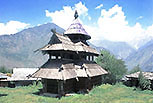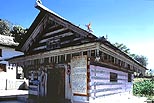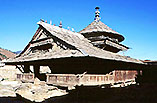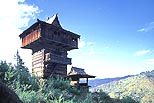| A JOURNEY TO HIMACHAL PRADESH ’98 |
TAKEO KAMIYA
| A JOURNEY TO HIMACHAL PRADESH ’98 |
Though it is not easy to travel to Himachal Pradesh for beginners, I intended to travel there for two weeks this time; I stayed in Delhi before and after my trip. I was scheduled to fly to the town of Kullu in Himachal Pradesh in an 18-seater propeller plane. There had previously been the government–managed airline, Vayudoot Air, but it disappeared after the economic liberalization of India, and many private air companies came to fly small planes to various cities. I bought an air ticket of Jagson Airlines to Kullu for the flight on the next day at its office near Connaught Place. However, because the pilot was missing or something, the flight was cancelled. I had to take a long-distance bus to Chandigarh, and then hire a taxi immediately to Kullu. I took a dinner hastily at the old Raj Mahal Hotel in Mandi on the way, and I finally arrived at Hotel Sarvari in Kullu at midnight.
The Kullu Valley along the Beas River has a beautiful landscape continuing to the northernmost town of Manali and its road is well maintained. Due to border and religious disputes in the Kashmir region, the number of tourists and summer visitors has sharply dropped and they now flow into the Kullu Valley. Manali in particular has greatly prospered in recent years, seeing an abundant increase in hotels.
  Parashar Rishi temple by the side of Parashar Lake
One of the centerpieces in this journey was the Parashar Rishi Temple close by the small Lake Parashar 2,700m above sea level, which I had not been able to visit the previous time because of the collapse of the mountain road en route, caused by torrential rain. This time, I could reach the temple in fine weather, still spending close to four hours by car from Kullu.
 A sketch of the Yogini temple at Chaini by O.C. Handa
There are many temple towers, or temples of the Square-Tower type, treated in the pages of ‘Wooden Architecture in India’ in this website, in the Sutlej Valley between Shimla, the capital city of the state of Himachal Pradesh, and Recong Peo, the capital of Kinnaur district in the state. The most prominent temple tower is the Yogini Temple at Chaini, which the Indian scholar O. C. Handa visited and made a sketch of. However, its proportion was too excessive and any no photos had been published, furthermore when I went to the old town of Chini (current Kalpa) in Kinnaur district, I found nobody knew this temple, therefore I assumed that this temple must have been lost, or else Handa’s sketch must have been outrageously exaggerated.
  Yogini temple at Chaini
However, I unexpectedly discovered this temple extant at this time, not in Kinnaur district but in a district in an utterly different direction, soaring at a village named Chaini (also called Chehni-Kothi) in mountain highlands. It stood just like in Handa’s sketch, at a height of about 30m. As Chaini Village is located midway between Gondla and the Sutlej Valley, thus came to be filled the missing link between the square-tower fortress and the temple tower. And yet it is still a subject to be researched whether it has any connection with the tower-type dwellings of distant Georgia in the Middle East.
  [Reference] Tower Houses in Georgia
Though I intended to go to Manali from Kullu, and furthermore to Gondla and Udaipur in Lahaul district, the Rohtang Pass, 4,000m above sea level, had already been closed by snow. Knowing that it was impossible to cross the pass, I changed my plans at once, taking a night bus to Shimla in the opposite direction. Still, the bus broke down on the way, obliging us to spend one night in the bus at a remote place. Although a substitute bus came at dawn, we arrived at Shimla at 10 o’clock instead of the initially scheduled 5 o’clock. I hired a van-type taxi in Shimla for five days for a round trip to Recong Peo near the Chinese border, stopping at many temple sites on the way, and spending nights at Narkanda and Sarahan. The total distance of my journey was about 600km and the average speed of the car was only 25km per hour due to the rough mountain roads.
Among the numbers of wooden temples that I visited or revisited, I was most deeply astonished with the Maheshwara temple at Sungra, which had become darker through the elements during the five years since my last visit. It had lost its excellent fresh and clean appearance, entirely made of plain wood, even for its roofing.
  Maheshwara temple being painted on the wall, Sungra The Himalayan primitive wood carvings, painted in red, blue, yellow on every part, give an impression of vulgarity or the feeling of comics instead of the sacredness of religious architecture. It is probably the influence of the South Indian manner of temple painting, especially in Tamil Nadu. It is lamentable to see such conditions in the Himalayan administration for cultural protection. How bitter to see that, corresponding to the invention of traffic convenience for both people and information, a traditional architecture, which is suitable to the region, is being destroyed. I heartily pray that the gaudy painting of wooden temples in Himachal Pradesh will be stopped soon. As they are, they stand in harmony with the view of natural scenery, environed with snow-covered mountains and deodar trees. |
|
CLASSIFICATION OF TEMPLE TYPES
|
|
Many scholars and travelers, such as A.F.P. Harcourt, Penelope Chetwode, Mian Goverdhan Singh, and Ronald M. Bernier, have classified and named the wooden buildings in Himachal Pradesh. Although I once adopted Harcourt’s nomenclature, such as "Chalet type" and "Pagoda type," I have been thinking those names inappropriate and the classifications unclear and unsuitable. So I show here my own idea of the classification and nomenclature, adding some typical examples.

2. MULTI-TIERED TOWER TYPE (or 'Pagoda' type) : Similar to Japanese and Nepalese Multi-tiered tower type

3. COMPOUND TYPE (Gable Roof + Multi-tiered Tower) : A wooden version of the [Garbhagriha + Mandapa] composition in a stone temple

4. SQUARE-TOWER TYPE (Temple Tower) : Originated in Himalayan folk houses (1F for animals、2F storage、3F residence)

Although the ages of their constructions are based on works by O.C. Handa and others, it is difficult to fix them exactly, since in actuality a wooden building is constantly repaired and often rebuilt because of the intense damage it suffers if even its roofing is timber. It is also not clear how much detail is contained in the records of each temple, we must await the researches and reports of local historians.
Among these temple types, the Temple Tower (Square-Tower type temple) is the most problematic. A grand scale one was generally used as a keep of a fort too. They are supposed to have either kept only the function of a temple after the independence of India along with the extinction of small princely states, or been abandoned and collapsed. On the other hand, many of them have been used as a Bhandar (sacristy), combined with another temple of the Gable Roof type or the Compound type. It indicates that form does not necessarily accord accurately with function in Himachal.

As a Square-Tower type building, which has not converted to a temple, there remains the fort of Gondla in the Lahaul district beyond the Rothang Pass in the north. As it is recorded that Buddha statues of Tibetan Buddhism were enshrined in this building, a mixture of Buddhism and Hinduism was performed there. Although the religious mixture is also seen in the Kinnaur district in the east, a Temple Tower does not exist beyond Labrang, clearly showing that the origin of the Square-Tower type temple is not in the sphere of Tibetan Buddhism. The influential relation with the westward, particularly with Central Asia and the Middle East, should be investigated. |